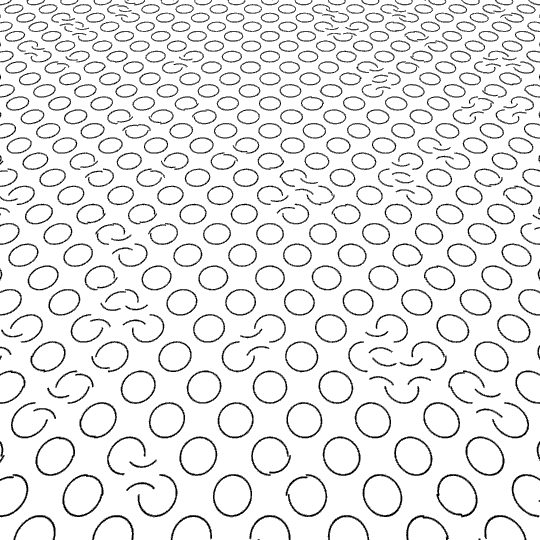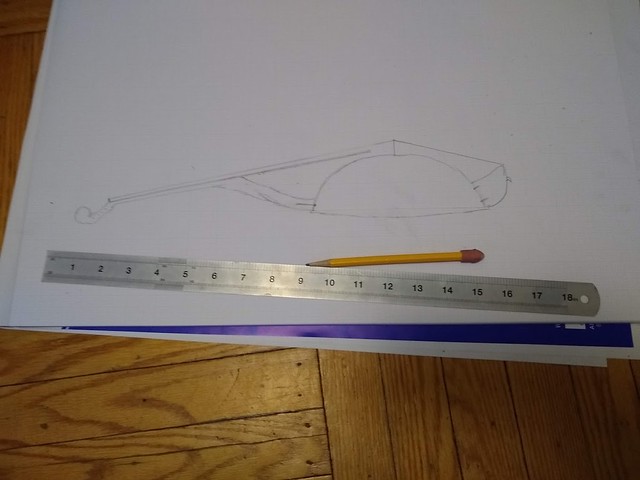|
|
Friday, January 31st, 2020

posted afternoon of January 31st, 2020: 1 response
➳ More posts about Pretty Pictures
|  |
Wednesday, January 29th, 2020
Check it out, from the pov of a piscene cartographer: an oceanic pangæa. The work of Athelstan Frederick Spilhaus:
 (Note this map is fantastic for faces. See them?)
↻...done
posted evening of January 29th, 2020: Respond
|  |
|
An issue in designing the brass viola, is what to use for a tailpiece. I cannot use a cello tailpiece, because the distance from the tail to the bridge is too short. My impulse is to use a viola tailpiece; however a much longer tailgut is needed than what is used for a viola (and I think longer than a cello tailgut), and I believe the thickness of it will be too great to fit in the holes drilled into a viola tailpiece. In addition, viola fine-tuners will not work because they are too small to accept cello strings.
My tentative plan is to use a viola tailpiece but drill new holes in it, and run a Bois d'Harmonie bass tailcord through the end of the tailpiece and around the middle; and to forego fine-tuners on the tailpiece and instead use geared pegs. I may in the end have to carve my own tailpiece but am hoping not.
 Update: a genius idea from the Cello international forum on FB: In lieu a tailpiece, use two loops of kevlar thread and four brass rings -- each of the strings effectively gets its own "tailpiece".
posted afternoon of January 29th, 2020: Respond
➳ More posts about viola d'ottone
|  |
Sunday, January 26th, 2020
I want to lay out how I came to the point where I'm about to start making and putting together the brass viola. I will readily admit here that I'm hoping the project will be a success; that the instrument will sound, in the end, like an instrument. I'm pretty optimistic right now, not having begun yet to layout any parts, except on paper. (And if it comes out the other way, please read this charitably, or don't bother.)

 I think of the #tincancello as being a "banjo", in the sense that the steel soundboard functions as a flexible membrane taught between the bridge feet and the rigid rim of the washtub. (For a wooden cello the rigid element is the arched woundboard itself.)
It seems to me, and I intend to verify, that it will be interesting to build a metal soundboard instrument with a soundboard that's arched and rigid-- it occurred to me several months ago that a wok could work for that. I will make a wooden neck and dowel using a roughly similar layout as the #tincancello . (The principal difference here is that the dowel will run through the very rim of the wok, instead of through the middle of the washtub.) I will also carve an arched back. My hunch is that this will produce an ideal resonating chamber.
Bracing as appropriate at the point where the neck meets the body and where the tail meets the body will allow the soundboard to resonate completely free of the tension of the strings. I'm hoping the brass will ring like a bell under these condition; and I'm making a primary assumption, that the pan will be light enough, and rigid enough, for the vibration of the bridge to really transfer to it. This is the primary factor that will determine the success or failure of the project. (Analogy to the #tincancello soundboard is not worthwhile for the reasons outlined above.)
↻...done
posted morning of January 26th, 2020: 1 response
➳ More posts about Projects
|  |
Saturday, January 25th, 2020
Last night it occurred to me (still waiting on delivery of the pan that will be the body of the brass viol) -- I've been thinking of this instrument all along as having a dowel through the body, similar to the other instruments I've built. But if the pan is rigid and strong, it might make more sense to have a separate neck and tail, attached to the pan with bolts. I think this would offer a few key advantages:
- The resonating chamber would be hollow, like a violin's. It seems intuitively like this would produce a clearer tone.
- The joinery would be more straightforward. It will be easier to line up and drill holes in the pan, than to lay out and cut mortises for the dowel.
- The shape of the tail would no longer be limited to an extension of the dowel. I could give the tail height, so the tailpiece would attach closer to the height of the bridge feet. Then the string angle would not be so sharp on the tail side.
(Update: nm, this was a silly idea. The instrument pictured would sound horrible if indeed it would tension up at all.)

posted morning of January 25th, 2020: 3 responses
|  |
Monday, January 20th, 2020
Getting the correct string angle across the bridge is going to be really critical to laying out this instrument. The angle to the tailpiece looks like it will be pretty sharp, from my drawings. I will probably need to lower the bridge aomewhat -- indeed I may go back to the idea of using a viola bridge instead of da gamba. But I really need to see the pan to know, for now I am just guessing. Waiting impatiently on delivery.
The strings should cross the bridge at 153°. Possibly a few degrees sharper, the metal pan as I'm picturing it could stand a fairly strong tension. So that's around 77° on each side from the axis that's the bridge. I think I can make the bridge tilt back some by moving it back on the face of the pan, that will even up the angles.
posted evening of January 20th, 2020: 2 responses
|  |
|
Starting out... will add specs as I calculate them. For reference, Alan Goldblatt's cello specs.
viola d'ottone/ viola.1/ the tenor brass viola
| scale length | 535 | mm | (using ¼ size cello strings) |
| fingerboard length | 490 | mm | (on treble side -- cut away 25mm toward bass) |
| fingerboard width (nut) | 28 | mm |
| fingerboard width (end) | 60 | mm |
| fingerboard height at edge | 6 | mm |
| fingerboard radius | 70 | mm |
| dowel height | 3/4 | in |
| neck angle from vertical | 83 | ° |
| shoulder location | 110
60 | mm
mm | back from heel
above heel |
| neck length under fingerboard | 250 | mm |
neck blank 8/4
(maybe could use 6/4) | 28
7 | in
in | long
wide |
posted evening of January 20th, 2020: Respond
|  |
Saturday, January 18th, 2020
I dreamed I was the Red King, dreamed
I was Rip Van Winkel.
posted afternoon of January 18th, 2020: Respond
➳ More posts about Tweedledum and Tweedledee
|  |
Wednesday, January first, 2020
The instrument will consist of a round metal dome (either steel or more likely, brass) as a soundboard, a neck and dowel cut from one piece of wood (most likely, cherry)*, steel strings, and a maple bridge, most likely one made for a treble viola da gamba. The significance of the dome shape is, that the bridge can sit on or close to the center of the soundboard, for maximum resonance, without the edges of the pan interfering with the bow stroke.
The scale length will be about 20". Four strings, with tuning of a tenor violin -- G2, D3, A3, E4. I will use strings from a fractional cello for the lower 3 and a full-size cello E string for the top string. (E string for fractional cello doesn't seem to be manufactured anywhere, and the luthier I contacted to ask about it recommended using the full-size string.)
I have a steel wok. I believe the metal is too thick for it to resonate well. I also think it would be possible but quite difficult to grind the metal at the center of the disk thinner using an angle grinder. No guarantee this would increase the resonance but my hunch is it would. I have also ordered a brass wok, which has not arrived yet; I'm thinking it will be the thing to use -- accordingly I'm referring to the instrument as a "brass viol". The arch shape of the brass pan seems like it will be better for sound and for attaching a lining. If there is any question of grinding the pan's thickness down brass must be a lot easier to grind away than steel. Also brass wins for the pretty factor.
I'm planning to build the rest of the instrument besides the back and rough-string it to see what it sounds like prior to carving the back.
Slowly assembling the materials I'll need for this.

- soundboard: brass pan
- ✓ wood for neck
- fingerboard, nut
- ✓ wood for brace
- tailpiece
- pegs
- ✓ bridge
- strings
- ✓ wood for back
- ✓ purfling for back
- soundpost
* Also I think I will need a brace at the bottom of the pan, which I'll make from basswood or willow.
↻...done
posted afternoon of January first, 2020: 2 responses
|  |
Blocky capital letters
of flame
in retro fonts imagined:
fluid flaming fonts, canvas of blacky void
so melt away their meanings
so what's left amounts
to glyphic shapes, just shapes and sounds
and chunky, palpable
consonantal feel.
posted morning of January first, 2020: Respond
➳ More posts about Poetry
| Previous posts
Archives  | |
|
Drop me a line! or, sign my Guestbook.
•
Check out Ellen's writing at Patch.com.
| |